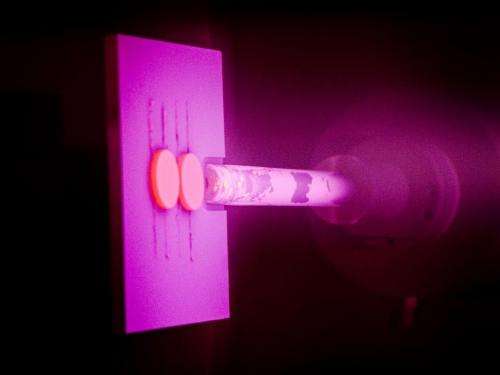Image: Pretty in pink

(PhysOrg.com) -- Inside the Plasma Spray-Physical Vapor Deposition, or PS-PVD, ceramic powder is introduced into the plasma flame, which vaporizes it and then condenses it to form the ceramic coating.
The PS-PVD rig at NASA's Glenn Research Center uses new technology to create super thin ceramic coatings, which are being developed to protect high efficiency engines. The coatings created in the PS-PVD rig are thinner and more complex than those previously available.
The PS-PVD rig uses a system of vacuum pumps and a blower to remove air from the chamber, reducing the pressure inside to fraction of normal atmospheric pressure. The plasma flame is extremely hot and reaches 10,000 degrees Celsius. Ceramic powder is introduced from the torch into the plasma flame. The plasma vaporizes the ceramic powder, which then condenses 5 feet away from the torch onto the component to form the ceramic coating.
Plasma--not a gas, liquid or solid--is the fourth state of matter and often behaves like a gas, except that it conducts electricity and is affected by magnetic fields. On an astronomical scale, plasma is common. The sun is composed of plasma, fire is plasma, fluorescent and neon lights contain plasma. NASA’s PS-PVD rig is one of only two such facilities in the country and one of four in the world.
Provided by JPL/NASA


















